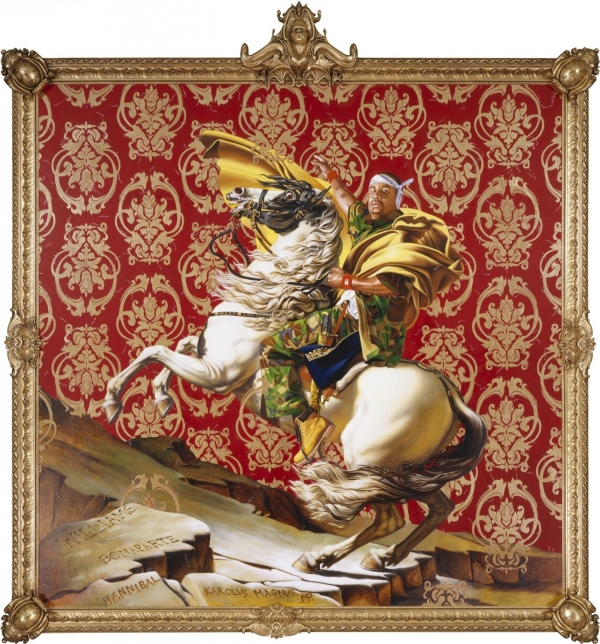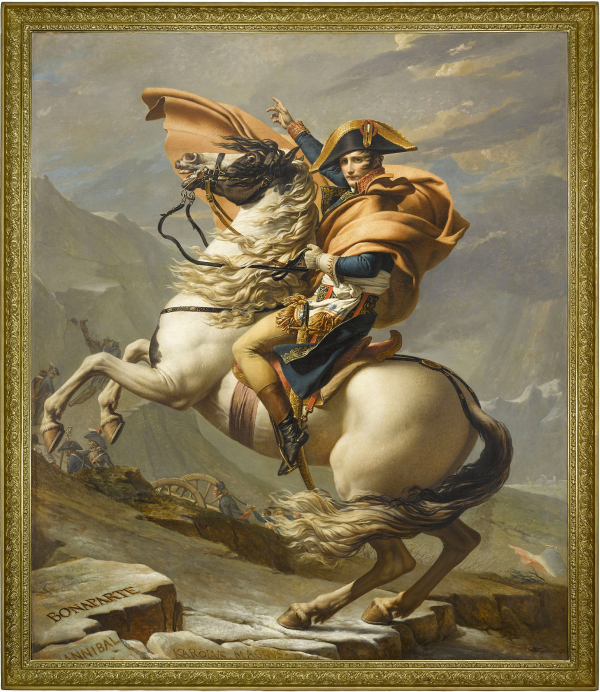Design as Symbolic Violence: How Far is Far Enough?
Posted on October 29, 2021
Kehinde Wiley (American, b. 1977). Napoleon Leading the Army over the Alps, 2005. Oil on canvas, 108 x 108 in. Collection of Suzi and Andrew B. Cohen. (Photo: Sarah DiSantis, Brooklyn Museum, taken from Brooklyn Museum’s website).
A guide to self-facilitating a dialogue with a painting:
Take a few minutes to look at this painting closely.
Feel free to jot down or draw anything you see that strikes you or sparks your curiosity.
Now that we have had a chance to look, what is going on in this painting?
What do you see that makes you say that? (WDYSTMYST?)
What more can we find?
Repeat these last two questions to make your way across the painting both visually and conceptually. Make sure you follow each observation with the question “What do you see that makes you say that?” This is to ensure your responses are grounded in visual evidence rather than mere conjecture.
Here are some other questions to consider as you look at this painting:
Did you notice the subject’s pose? What about the subject’s clothing? What do both tell you about the subject? WDSTMYST? What colors do you notice in the painting? What associations or feelings do those colors evoke? Did you take note of the names on the bottom left corner? Why do you think the artist would include them? Did you notice all the tiny sperm in the background of the painting? Why would the artist add this detail? (I am genuinely asking because I am not entirely sure).
Once you are satisfied with your inquiry into this first painting, we are going to look at the next painting:

Jacques-Louis David, Napoleon Crossing the Alps, 1803 version, oil on canvas 275 × 232 cm (Österreichische Galerie Belvedere)
Take a few minutes to look at the painting
What is going on in this painting?
What do you see that makes you say that? (WDSTMYST?)
What more can we find?
Does it look familiar? How is it similar and different to the first painting we observed?
The first painting is by Kehinde Wiley (which you may already know either from previous knowledge or from reading the caption underneath the image). He is a New York based artist originally from Los Angeles1. In order to find subjects for his portraits, Wiley has a process called “street casting” 2 wherein he invites black Americans he encounters on the street to his studio. Once there, he gives the models books filled with images of classical portraiture. He allows the models to choose what classical masterpiece they will reproduce and how they want to pose. The models are usually painted in their personal clothing and Wiley includes the visible brand names of accessories, shoes or other clothing items. The second painting, by Jacques-Louis David, was commissioned in the early 1800s by the Spanish king Carlos IV to commemorate Napoleon’s victorious military campaign against the Austrians (although, in reality, Napoleon’s military campaign against the Austrians was not victorious). Napoleon is depicted in the “heroic tradition of equestrian portraiture”3. It oozes authority and through his right, ungloved hand, Napoleon points towards the new summit the French are about to reach.
Through replacing white aristocrats with contemporary black men and women, Wiley makes visible the absence of black subjects from historical and cultural narratives, especially those surrounding power. By allowing the models to choose how they are depicted, he starts a very necessary conversation about agency over the way one’s image is portrayed. These paintings force the viewer to wrestle with concepts of identity, class, race and power within the western centric artistic lens. Kehinde Wiley’s work does as Mignolo’s argument suggests in Design as Symbolic Violence by Boehnert and Onafuwa and attempts to “de-link” West-centric design from coloniality “through a pluriversality of perspectives, or alternatives to a single reality concept.”4 In fact, his artwork wrestles very directly with the violence of design, particularly the lack of representation and the “manufacturing of certain subjectivities” that anthropologist Juris Milestone describes wherein “Design disciplines the public by encouraging social hierarchies where people distinguish themselves with their ‘good’ taste and commitment to quality”5. This can be seen especially with the choice of clothing and the intentional addition of certain brands and styles in the paintings.
I worked at the Brooklyn Museum for a year from 2018-2019 as an art educator and taught with Kehinde Wiley’s Napoleon Leading the Army Over the Alps (pictured above) various times. Currently, I am working part time for the museum and his presidential portrait of Obama was on display. I, almost unquestioningly, thought that his artwork was successful at addressing and bridging some of these gaps created by violent design. However, an art teacher I work with brought up a criticism recently that has left me thinking. In these paintings he is supposed to be empowering the black men he uses as models but does he really? At the end of the day who are these paintings really benefiting if he is selling them to rich art patrons and profiting off the depiction of these black bodies? How empowering is it if these models got to choose how they are depicted but not where their depiction ends up? I believe Wiley brought up this same criticism of his own work during an artist talk. Is acknowledgment and self-awareness enough? I still think there is a lot of value in seeing these paintings in museums subverting white narratives of power and overall, I still think his work sends a clear and important message about racism, classism, sexism and many other ‘isms’. These criticisms have left me pondering however, how far do we have to go to subvert the violence often embedded in design? How far does the individual designer (or artist’s) responsibility extend? I don’t have answers to these questions but will continue to chew on them as I explore my own design practice. At the very least, I hope they help me sit in and wrestle with the nuance of violence in design.
-CE
Sources:
- FAQ, Kehinde Wiley, https://kehindewiley.com/
- Napoleon Leading the Army over the Alps, The Brooklyn Museum.
- Jacques-Louis David Meets Kehinde Wiley, The Brooklyn Museum, January 2020.
- Design as Symbolic Violence by Boehnert and Onafuwa, School of Arts and Communication, Malmö University, 2016, pg. 10
- Ibid, 3